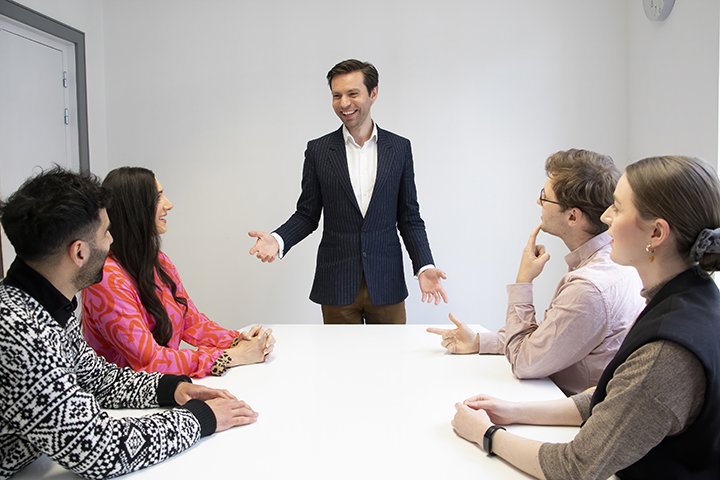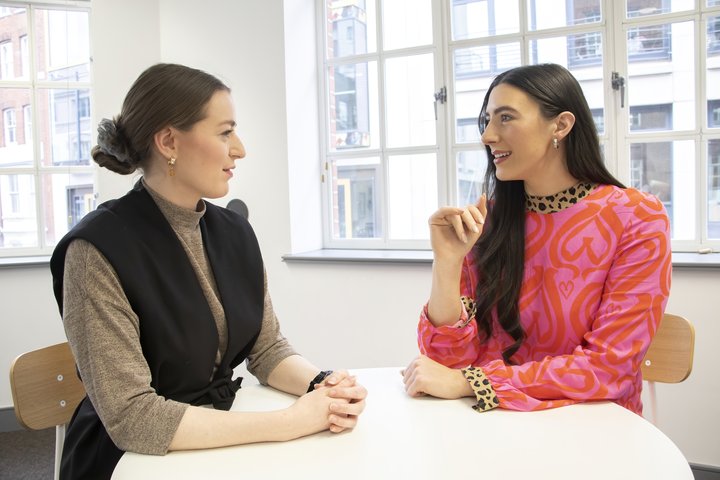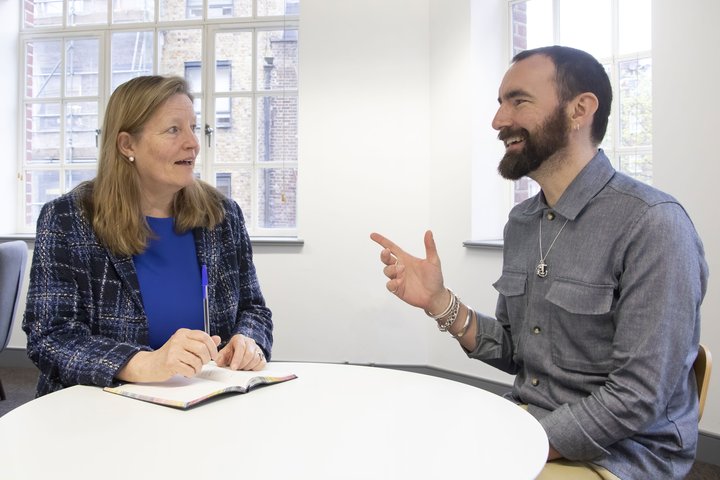Creating a culture of trust in your team
What does it feel like to be in your team? Does the environment feel safe and trusting enough to risk offering new ideas to the table without fear of embarrassment or judgement? Leaders of teams can help create this feeling and draw out the best from each colleague, and the collective responsibility of each team member to establish and maintain the environment free of judgement.
RADA Business Practitioner John Hoggarth says that the key to developing an engaged, effective and innovative team that trusts in your leadership is to create an environment where people feel safe to share ideas, and make their voices heard.

“In the theatre, we test things through the rehearsal process. Having gone through that process, we ask: ‘what have we learned, and how might we apply that to the production?’” John says that this approach of working through a problem, testing evolving ideas and refining them, deciding what works, and implementing those ideas, can also be applied to the world of business.
“This process of testing and daring to fail is something that actors are very familiar with, but it isn’t as common in business,” says John. “People commonly resist applying this technique to the world of business, as they feel they just can’t afford to fail.” Many leaders bring that fear of risk to the way they run their teams and line manage colleagues, thereby stifling creativity and trust.
In business, you don't always get three weeks of rehearsal time to explore ideas; sometimes clients have tight deadlines and decisions need to be made in the moment. So how can leaders successfully apply this approach and provide an environment that both allows people to reach their full potential and also builds stronger teams?
Create a space where ideas are encouraged and supported
Giving your team the permission to share ideas, speak up, and fully express themselves is priceless. The first step is to create a space in the workday where ideas are supported and encouraged; perhaps in strategy meetings, or as a weekly update session.
“Design an environment that allows creativity to flourish. That doesn't necessarily mean that there are no limits, it’s just about changing the atmosphere, and creating a place where people feel like they have agency and can also take a risk.”
As a leader, it’s key that you clearly communicate to your team that they are in a space of honesty and openness, where they can be fully heard and respected for sharing their thoughts. “You need to create comfort and trust, and remove judgement,” says John.
However, your team will still need your stability as a leader. “Your team needs to feel secure that this isn't about you handing over all authority and accountability. They still need to feel supported by you. If people do feel secure, that you’re there as a safety net, they will be more open.” Remember to be curious about how your team is contributing; check in with them regularly to make sure that people feel comfortable to actively participate and make their presence felt.
There are times however, when creating a space for free thinking is appropriate. It’s your role as a leader to identify and clearly communicate when it’s not an appropriate time to openly share free thinking. For example, when pitching to a client, your team needs to present a united front; it’s not the time to bounce around ideas. “You don’t want to be taking huge risks when it really counts. But there will be occasions where ideas are worth encouraging and experimenting with, so you can try things in a new and fresh way.”

Set parameters
Go into the meeting with a broad idea of what you want to get out of it and remember to communicate this to your team. Setting parameters allows your team to focus on a goal, but also gives the opportunity for exploration. You might communicate that you want to use the time to find a resolution to a client brief, for example.
“People can make the mistake of thinking that there are no limits in these meetings. Of course, you want to provide an environment that promotes creativity, but at some point the ideas stage comes to an end, and you need to move onto the next stage of the process, whether that be implementing a new strategy, or presenting your ideas to a client.”
You need to be explicit about the purpose of the meeting so that people understand their role within it, says John. Clearly state the purpose of your strategy or planning meeting to ensure that you’re all on the same page.
“You need to clearly explain what you’re doing, what you want to get out of it, and what areas can be explored. As a leader, you will have to make decisions. It's the journey you and your team take to get to those decisions and what you allow along the way that will make people feel engaged and part of the process.”
Be open-minded
Once you’ve carved out time in the workday to meet with your team, set expectations and defined clear parameters, the next step is to enter the process with curiosity and an open mindset. Make it clear that your team can contribute without judgement.
“You do need to have a clear purpose and a sense of the direction of travel, but you can’t necessarily be fixed on the solution or the end result,” says John. “That takes a level of courage as a leader, because it does feel like you're letting go.”
Take a lesson from the world of theatre: lean into the principles of improvisation to generate new ideas.
“Often, when teams hear the beginnings of a great idea, people start finding reasons why it won’t work before the idea has been given space and time to really evolve. We could call this a ‘yes, but’ mentality. That’s a very easy place to be if you’re restricted by budget, time, habit or culture. It's very easy to fall into that position of ‘yes, but we've tried that’, or ‘yes, but that will never work.’”
“You need to get into the mindset of taking an idea and building on it, by adopting a “yes, and” mentality. This will allow you to nurture the idea and build it from infancy into something much more complex and structured.”
Create space for your team to flourish
People don’t just want to be in a team, they want to feel that they can actively contribute to the business’ success. Give your team the opportunity to contribute by creating pockets of time for candour and openness and remember that it’s your role as leader to clearly communicate the end goal, set parameters, and make sure that your team feels valued.
In the same way that working together in rehearsals builds rapport amongst actors, this sharing environment will allow you to know your team in a fuller way, says John. “By creating an environment where people feel safe and trusted, they will start to share ideas, suggest new approaches and bring renewed passion to work. You’ll find that people will reveal greater ‘out of the box’ ideas rather than being constricted by the job description and a hierarchy. This means that you’ll be able to get the full potential out of your team, and people feel more fulfilled and more engaged as a result.”

